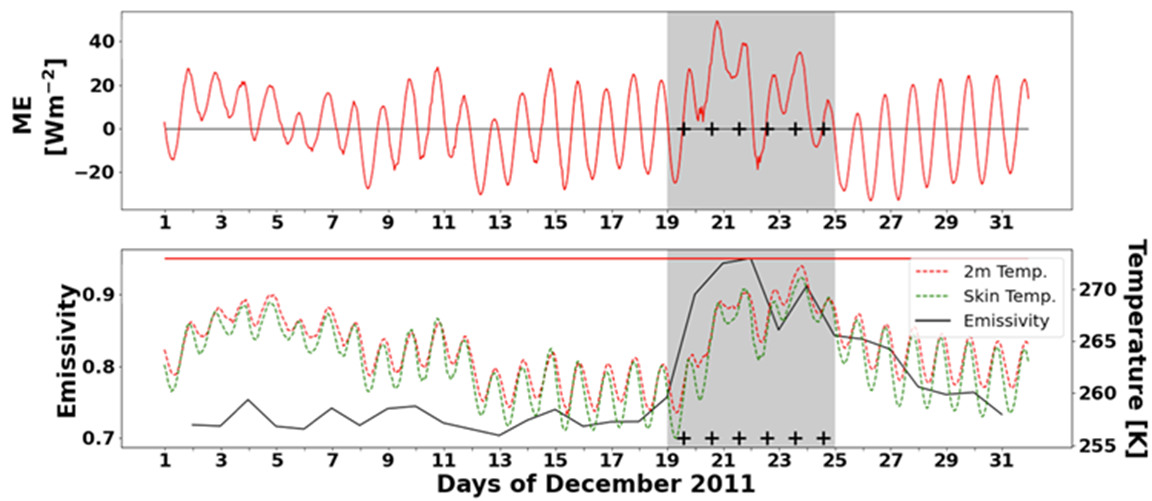Energetics of surface melt in West Antarctica
Submitter
Lubin, Dan — Scripps Institution of Oceanography
Vogelmann, Andrew M.
— Brookhaven National Laboratory
Area of Research
Radiation Processes
Journal Reference
Ghiz M, R Scott, A Vogelmann, J Lenaerts, M Lazzara, and D Lubin. 2021. "Energetics of surface melt in West Antarctica." The Cryosphere, 15(7), 10.5194/tc-15-3459-2021.
Science

Figure 1. Example of a surface melt event over the Pine Island and Thwaites Glacier region. The shaded region denotes the melt period, and the black crosses indicate the satellite evening overpass times. (Top) Time series of the total hourly melt energy (ME) into the snow/icepack. (Bottom) Time series of the skin temperature, 2m air temperature, and surface emissivity from SSMIS satellite microwave brightness temperatures. The horizontal red line is at 273.15 K. Note that the ME remains positive for over four full diurnal cycles during the satellite-detected melt period, inducing steadily rising 2m air and skin temperatures. From journal.
The contribution of West Antarctic mass loss to sea level rise is driven by a complex mechanical and thermodynamic system. While a warming ocean causes a retreat of ice sheets, surface meltwater can further compromise the structural integrity of an ice shelf by filtering through crevasses into its interior mass. This study determines how meteorological conditions alter the surface energy balance to cause the surface melt detectable in microwave satellite imagery.
Impact
Our results detected and analyzed three primary mechanisms for inducing surface melt. This type of analysis can enable quantitative prediction of atmospheric stress on the vulnerable Antarctic ice shelves in a steadily warming climate.
Summary
Reanalysis data and satellite remotely sensed cloud properties were used to determine the components of surface energy balance during melt events that were detected by microwave satellite imagery. The total melt energy (ME) into the snow/icepack consists of the total net radiative flux, net turbulent flux, and ground conduction, the latter of which is typically an order of magnitude smaller than the other terms. The reanalysis and satellite-derived estimates of surface shortwave, longwave, and turbulent fluxes were calibrated and validated using the observations made during the AWARE Field Campaign. This study serves as an example of how the point-observations made at an ARM site can be generalized to an entire region of interest for climate change. Further case studies were performed over Pine Island and Thwaites glaciers, of interest for ice shelf and ice sheet stability, and over Siple Dome. Our analyses exhibit three primary mechanisms for inducing surface melt: (1) thermal blanketing involving sensible heat flux and/or longwave heating by optically thick clouds, (2) all-wave radiative enhancement by optically thin cloud cover, and (3) föhn winds that occur on the leeside of high terrain during adiabatic descent and heating, after the preceding ascent during which moisture condensed out of the air mass.
Keep up with the Atmospheric Observer
Updates on ARM news, events, and opportunities delivered to your inbox
ARM User Profile
ARM welcomes users from all institutions and nations. A free ARM user account is needed to access ARM data.


















